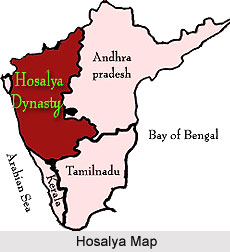 Ballala III was the last great king of the Hoysala dynasty. This powerful king confronted various other kings of Karnataka like the Seunas, Kadambas and Santharas. With a desire to help Sundara Pandya, of the famous Pandyan dynasty of Madurai in the Tamil country against his step brother Vira-Pandya, he led his army to the south, only to find his capital Dvarasamudra (Halebid near Mysore) attacked and ravaged by the army of Allaudin Khilji, the Sultan of Delhi. The Muslim army led by Allaudin`s general Malik Kafur, destroyed Devagiri, the capital city of the Seuna dynasty and reached Dvarasamudra in 1311 A.D. Ballala III went back to his capital city and with no other alternative, submitted to the Sultan`s army and also sent his son Vira Virupaksha with Malik Kafur to Delhi. This was done by him to gain time to regroup his forces to face his enemies.
Ballala III was the last great king of the Hoysala dynasty. This powerful king confronted various other kings of Karnataka like the Seunas, Kadambas and Santharas. With a desire to help Sundara Pandya, of the famous Pandyan dynasty of Madurai in the Tamil country against his step brother Vira-Pandya, he led his army to the south, only to find his capital Dvarasamudra (Halebid near Mysore) attacked and ravaged by the army of Allaudin Khilji, the Sultan of Delhi. The Muslim army led by Allaudin`s general Malik Kafur, destroyed Devagiri, the capital city of the Seuna dynasty and reached Dvarasamudra in 1311 A.D. Ballala III went back to his capital city and with no other alternative, submitted to the Sultan`s army and also sent his son Vira Virupaksha with Malik Kafur to Delhi. This was done by him to gain time to regroup his forces to face his enemies.
Subsequently, in 1327, Mohammad Bin Tughlaq who had by then become the Sultan of Delhi sent his army against Ballala III as he had withdrawn his allegiance to Delhi. For the second time in succession, the Hoysala capital was ravaged and plundered and Ballala had to flee to Tiruvannamalai in the Tamil country for safety. The army from Delhi marched on to Madurai and conquered the Pandyan kingdom and this paved the way for the foundation of the Sultanate of Madurai.
Having being aware that he was the only Hindu ruler left in the South who could prevent the Muslim armies following the defeat of the Seunas, the Kakatiyas of Warrangal (Andhra Pradesh) and the Pandyas who had been completely removed from the scene, Ballala made Tiruvannamalai his temporary headquarters and set about organizing his forces to counter the invasions from Delhi. Meanwhile, he also built a second capital of die Hoysalas known as Hosapattana on die banks of the river Tungabadhra.
Ballala marched against the Sultan of Madurai and won a deceive victory against the latter`s army. However, a sudden attack by the Muslim army took the Hoysala forces by surprise and in the confusion that followed his army scattered and the king was taken captive. This heroic ruler was beheaded in a gruesome manner in 1343 A.D. by the Sultan. The well-known Muslim chronicler Ibn Batuta, who visited the kingdom of Madurai during this time, gives a graphic description of the way he was killed.
Thus came to a pathetic end the reign of a brave ruler of a famous dynasty. His heroic actions paved the way for the Vijayanagara forces to later take up the work of preventing the armies of the north from entering South India.



















